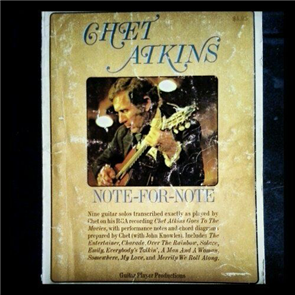Guitar by Randy Buckner
Part One: “Chet Atkins Note-for-Note”
Monday, September 9, 2019 by Randy Buckner | Method Books
When I was in middle school, I ran across an ad in Guitar Player Magazine. The advertisement was for a book of songs recorded by one of my heroes, Chet Atkins. I immediately ordered it, because the songs were transcribed from my favorite album, "Chet Atkins Goes to the Movies." Here are my thoughts on one of the most important books in my collection.
The Book
Chet Atkins Note-for-Note
By Chet Atkins and John Knowles. Copyright June 1975, by Guitar Player Productions. 72 pages. Cost of my copy: $4.95.
Cost Today
I have found examples of this book on eBay and Amazon ranging in price from $45 - $100.
What's Inside
The majority of the text was written by Knowles, with exception of the preface, which was written by Atkins. It was handwritten by Knowles, then typewritten by his wife, Becky.
Introduction
The introduction - like all the text - was originally written in first person. Knowles wrote it as if he were teaching a student how to play Atkins' music. The publishers - thinking no one knew who Knowles was - changed the text to Atkins' voice.
In the introduction, Knowles' advice to follow the score while listening to the record helped me understand the relationship between music notation and the actual performance.
Knowles suggested that when listening to the recording, listen to the melody and bass individually; identify the intro, verse, and bridge; and to listen for Atkins' articulations.
Thumb Technique
This chapter explained Atkins' thumb-work in such a way, even a self-taught middle-schooler - like me - could figure it out.
First, Knowles explained why a thumbpick was essential for the Atkins style.
He then explained the concept of a steady bass rhythm, followed by examples of Atkins' alternating bass patterns written for seven different chords. As far as I was concerned, this was the Rosetta Stone of all things Atkins.
The chapter closed with an introduction to playing the melody on top of an alternating bass. Knowles demonstrated how different melodic rhythms - quarter, half, and eighth - fit together with the bass line. Very enlightening to a beginning thumbpicker.
Anticipating the Melody
This chapter, although shorter than the rest, really summed up the Atkins style.
Knowles showed us how, while playing a song, Atkins would anticipate the melody.
In other words, picking the melody slightly ahead of the beat, thus giving Atkins' music the lilt and swing which had evaded most mortal guitarists. Again, something I had not seen in a book before buying this one.
Harmonics
This chapter tied a neat little bow around Atkins' style for me. Knowles explained not only how to play artificial harmonics, but how to combine them with a pure tone.
Because I had bought this book so early in my journey as a student, I didn't understand why others found it hard to play harmonics. Knowles explained them in such a way, it was easy to play harmonics like Atkins.
However, for Knowles, it wasn't so easy. He originally thought Atkins was playing a scale entirely of harmonics.
Knowles called Atkins, and Chet explained the technique over the phone. After a long silence, the conversation went like this: "You haven't got it yet, do you?"..."No"..."You will. Call me back when you've got it."
Knowles went to work, and figured out the technique. As we now know, Atkins would alternate a harmonic with a pure tone, creating what Knowles calls a cascade of notes.
Knowles then devised a way to write a "cue note" on the staff, to show where a harmonic occurs in the music.
My next post will be about the songs in the book.
Randy Buckner.
Hoover Music Co.
Springfield, Mo.
www.bucknerguitar.us


